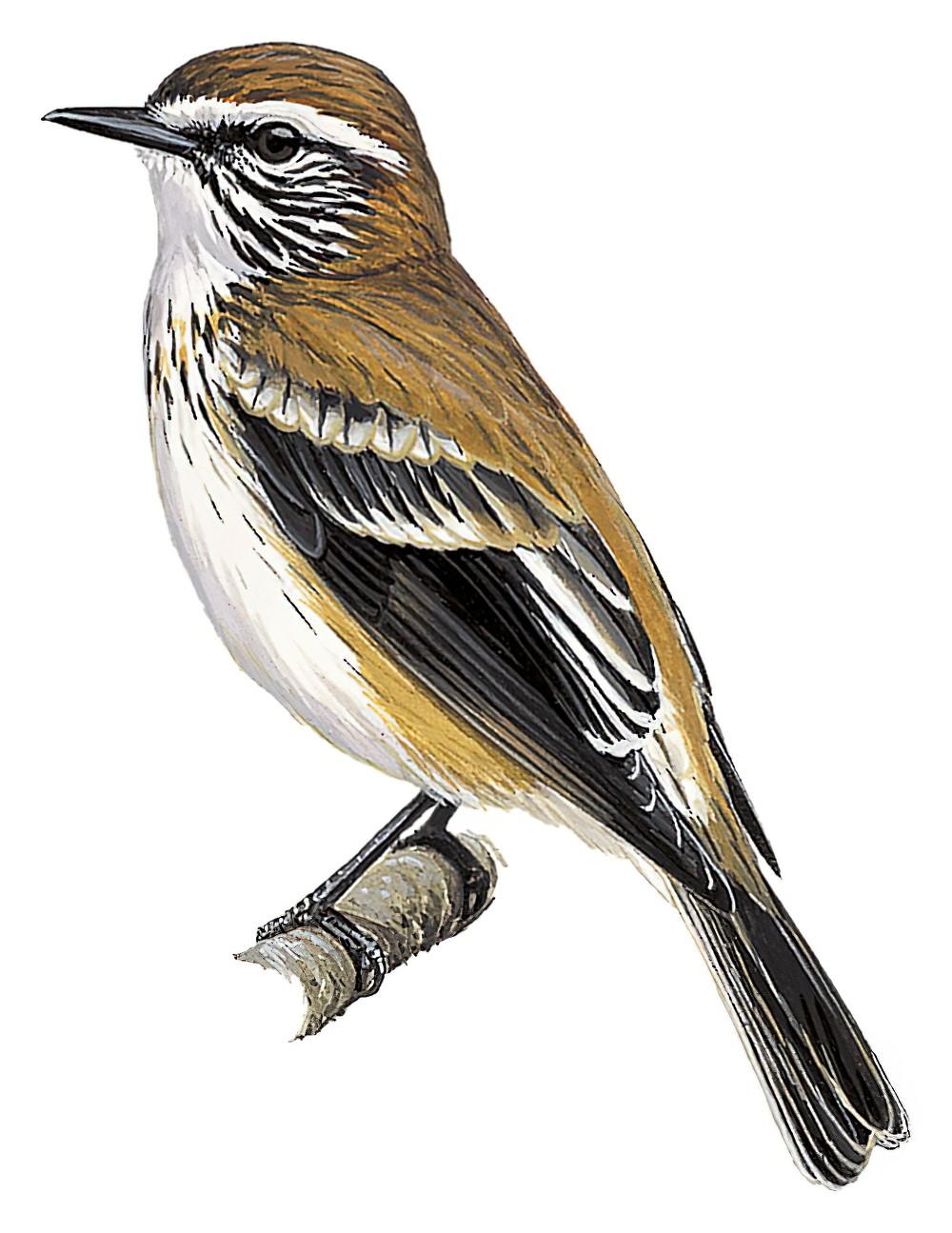Rusty-backed Monjita / Xolmis rubetra

Rusty-backed Monjita
SCI Name:
Protonym: Taenioptera Rubetra J.Orn. 8 p.247
Taxonomy: Passeriformes / Tyrannidae / Xolmis
Taxonomy Code: rubmon1
Type Locality: Sierra de Mendoza; type from pampa south of Mendoza, around San Carlos and Totoral, Argentina, fide Burmeister, 1861, Reise La Plata-Staaten, 2, p. 461.
Author: Burmeister
Publish Year: 1860
IUCN Status: Least Concern
DEFINITIONS
XOLMIS
(Tyrannidae; Ϯ White Monjita X. irupero) I cannot find this name in my dictionaries, and David & Gosselin 2002b, list it as a word of unknown origin. It may be a misreading of “Xomotl” of Hernandez 1651: “De Xomotl ... Avis est dorso et alis desuper nigris, ac pectore fusco” (Aztec Xomotl waterbird, perhaps some sort of duck), or perhaps be based on an unrecorded Güaraní name (although not found under “Pepoaza” in de Azara 1802-1805, nos. 201, 202, 203); "X. Fam. Muscicapiadae Vigors. Muscicapa Lin. 2 ... 2 Ferner könnten als Gattungen abgesondert werden: Knipolegus für Musc. lophotes Tem. und cyaneirostris Vieill. Az. 181; die Peposaza [sic] Az. (Xolmis), die sich in der Lebensweise den Arten der Gattung Oenanthe nähern und die Queues-rares (Xenurus) desselben. Alle hieher zu stellende Vögel zeichnen sich durch rauhe Stimme und die Gewohnheit aus, auf zweyflüglige Insecten zu lauren, und dieselben im Fluge zu haschen. Sie fitzen vorzugsweise auf dürren Zweigen und Aesten" (Boie 1826); "Gattung Xolmis 2 Pepoazo Azar. Hieher aus America: 1. Muscicapa moesta Lichst. Az. [= X. irupero] 2. — vittigera Lichst. Azar. [= X. coronata] 3. — mystacalis Spix tab. 31. [= Fluvicola nengeta] 4. — velata Lichst. [= X. velata] 5. — bicolor Gm. [= Fluvicola pica] Die Lebensweise dieser weiß und schwarz gefärbten Vögel nähert sich der der Steinschmätzer (Vitiflora Briss.), an die sie sich auch durch die Vertheilung der Farben ihres Gefieders anschließen. ... 2. Ξολμις, Isis 1826 S. 975." (Boie 1828); "Xolmis Boie, 1826, Isis von Oken, col. 973; based on "die Pepoasza" [= Las Pepoazás] of Azara, 1805, Apuntamientos Hist. Nat. Páxaros Paraguay Rio Plata, 2, pp. 164-175. Type, by subsequent designation (Sclater, 1888, Cat. Birds, Brit. Mus., 14, p. 10)1, T[aenioptera] irupero (Vieillot) = Tyrannus irupero Vieillot. ... 1 G. R. Gray (1840, List Genera Birds, p. 29) proposed "X[olmis] Nengeta (L.)" as type of Xolmis, but that species was not one of the six species included by Azara in his "Pepoazás," the sole basis of Boie's name Xolmis. Later, Boie (1828 Isis von Oken, col. 318) again used the name Xolmis, this time for five species, only three of which were among the original six. This time Boie quoted binomial names (taken from earlier authors) and by doing so he restricted the possible candidates for selection as types of the genus to these three." (Traylor in Peters 1979, VIII, 162).
Var. Xolmus.
Synon. Hemipenthica, Heteroxolmis, Hydrozetetes, Nengetus, Orsipus, Pepoaza, Pyrope, Taenioptera.
rubetra
● Albin’s 1731, name “Rubetra” for the Whinchat. Many early authors, including Linnaeus, confused the Whinchat and the Western Stonechat, using rubetra as a translation of Aristotle’s βατις batis a grub-eating bird, with ref. to the chats’ habitat (Gr. βατος batos bramble; L. rubus bramble ); "99. MOTACILLA. ... Rubetra. 18. M. nigricans, superciliis albis, macula alarum alba, gula pectoreque flavescente. Fn. svec. 218. & 230. t. 1. f. 3, 4. Muscicapa s. Oenanthe tertia. Aldr. orn. 735. Raj. av. 76. n. 4. Will. orn. 169. t. 41. f. 5. Curruca major altera. Frisch. av. . t. 22. f. 2. Rubetra. Alb. av. I. p. 50. t. 52. Ficedula s. Atricapilla alia. Jonst. av. . t. 45. f. ult. Ficedula 3. aldrovandi. Edw. av. 30. t. 30. Habitat in Europa." (Linnaeus 1758) (Saxicola) (see Batis).
● Late Med. L. rubetra small bird identified with the Stonechat Saxicola by Gaza 1476, and Turner 1544; the “Chat-like Pepoaza” of Hellmayr 1927 (Xolmis).
Rubetra
● (syn. Saxicola Ϯ Whinchat S. rubetra) Specific name Motacilla Rubetra Linnaeus, 1758; "The redstart's song considerably resembles that of the migrant furze-chat or "whinchat" of authors (saxicola-rubetra migratoria), consisting of short and rather plaintive detached staves" (Blyth 1836).
● (syn. Saxicola Ϯ Common Stonechat S. torquatus rubicola) Late Med. L. rubetra small bird identified with the Stonechat by Gaza 1476 and Turner 1544; "A variety of small black-headed birds are designated in different parts of Britain by the term Blackcap. The great titmouse (Parus fringillago), the marsh titmouse (P. palustris), the black-headed or reed bunting (Emberiza schœniclus), the stonechat (Rubetra rubicola), and even the black-headed gull, are all frequently called by this name" (Partington 1834).
UPPERCASE: current genus
Uppercase first letter: generic synonym
● and ● See: generic homonyms
lowercase: species and subspecies
●: early names, variants, mispellings
‡: extinct
†: type species
Gr.: ancient Greek
L.: Latin
<: derived from
syn: synonym of
/: separates historical and modern geographic names
ex: based on
TL: type locality
OD: original diagnosis (genus) or original description (species)












